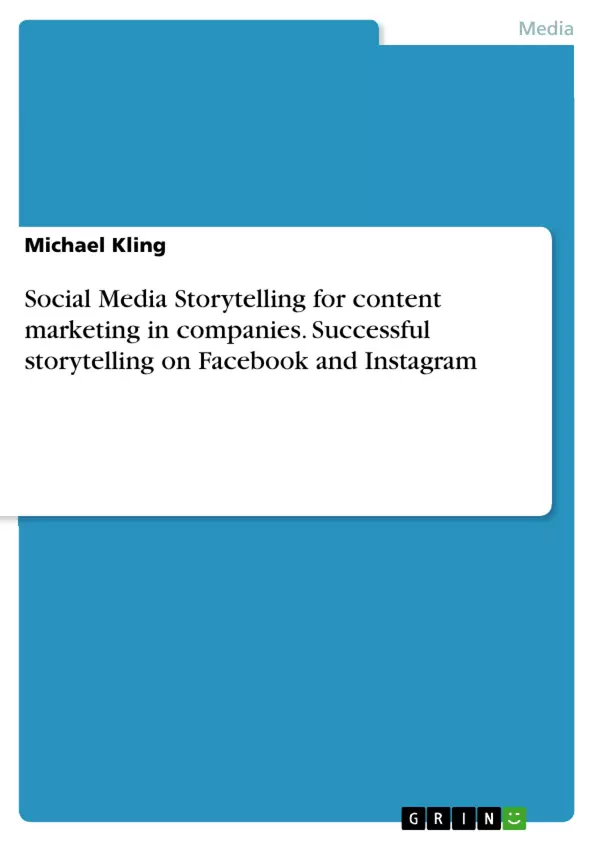Social media have created new framework conditions for the brand communication of companies. The majority of users have a shorter attention span, and mobile content is becoming increasingly important. In order to generate lasting attention, companies therefore use digital storytelling.
But what should a successful story look like? What special features do platforms like Facebook or Instagram bring with them? Michael Kling explains how storytelling works in social media and what companies should bear in mind.
Visual content is particularly important in design. Kling shows when videos and images are meaningful and how they can be supplemented with text overlays. His book offers support for content marketing in social media. In this way, companies achieve better perception and dissemination of their message than with conventional advertising messages.
From the content:
- neuromarketing;
- Online marketing;
- brand communication;
- visual storytelling;
- Digital storytelling
Inhaltsverzeichnis (Table of Contents)
- Abstract
- List of abbreviations
- 1 Introduction
- 1.1 Starting situation
- 1.2 Objective of the work and research question
- 1.3 Methodology and approach
- 1.4 Justification of the platform selection
- 2 Classification and meaning of central terms
- 2.1 Definition of enterprise
- 2.2 Definition of Content Marketing
- 2.3 Storytelling
- 2.4 Social Media
- 3 Why storytelling is important in content marketing
- 3.1 Necessity of content marketing and differentiation from classic marketing
- 3.2 The effect of storytelling in the brain
- 3.3 Content marketing needs good stories
- 4 Core elements for a successful story
- 4.1 Understanding the structure of a story
- 4.2 The Hero
- 4.3 The conflict
- 4.4 Emotionality
- 4.5 Appeal to all the senses
- 5 Visual storytelling as the supreme discipline in the digital age of storytelling
- 5.1 Definition Visual Storytelling
- 5.2 Images as a guarantee of success in digital storytelling
- 5.3 The effect of images in visual storytelling
- 6 Use of social media for corporate storytelling
- 6.1 Relevance of communication in social media
- 6.2 Relevance of storytelling in social media
- 6.3 Special features for storytelling in social media
- 6.4 Facebook as a storytelling platform
- 6.5 Instagram as a storytelling platform
- 6.6 Narrative structure and design of social videos in the newsfeed
- 7 Best practice analysis: the Hornbach hammer
- 7.1 Procedure
- 7.2 Action
- 7.3 Justification of the selection
- 7.4 Analysis of the narrative structure
- 7.5 Use of platform-specific features in Facebook
- 7.6 Conflict and Hero
- 7.7 Emotionality
- 7.8 Appeal to all the senses
- 7.9 Call-to-action
- 7.10 Final assessment
Zielsetzung und Themenschwerpunkte (Objectives and Key Themes)
This book aims to provide businesses with a comprehensive guide to utilizing storytelling on social media platforms like Facebook and Instagram for successful content marketing. It explores the essential elements of storytelling, its neurological impact, and how to leverage visual storytelling to create engaging and memorable content.
- The Importance of Storytelling in Content Marketing
- Key Elements of a Successful Story
- Visual Storytelling in the Digital Age
- Social Media Platforms for Storytelling
- Best Practices for Storytelling on Facebook and Instagram
Zusammenfassung der Kapitel (Chapter Summaries)
The book begins with an introduction that establishes the context for storytelling in content marketing, outlining the objective and research question. It then delves into the definition of key terms like enterprise, content marketing, storytelling, and social media, providing a solid foundation for understanding the concepts explored throughout the work.
Chapter 3 discusses the importance of storytelling in content marketing, highlighting its neurological effects and the necessity for engaging narratives. Chapter 4 explores the core elements of a successful story, emphasizing the importance of structure, conflict, emotionality, and sensory appeal.
Chapter 5 focuses on the significance of visual storytelling in the digital age, defining visual storytelling and explaining how images contribute to its success. The chapter further examines the impact of images in visual storytelling.
Chapter 6 examines the use of social media for corporate storytelling, addressing the relevance of communication and storytelling on these platforms. It also explores the special features of Facebook and Instagram for storytelling and provides insights into the narrative structure and design of social videos.
Chapter 7 analyzes a best practice example, the Hornbach hammer campaign, examining its narrative structure, use of platform-specific features, and overall effectiveness.
Schlüsselwörter (Keywords)
This book focuses on key concepts such as social media storytelling, content marketing, visual storytelling, narrative structure, engagement, brand perception, neurological effects, and platform-specific features.
- Citation du texte
- Michael Kling (Auteur), 2020, Social Media Storytelling for content marketing in companies. Successful storytelling on Facebook and Instagram, Munich, GRIN Verlag, https://www.grin.com/document/1175592



